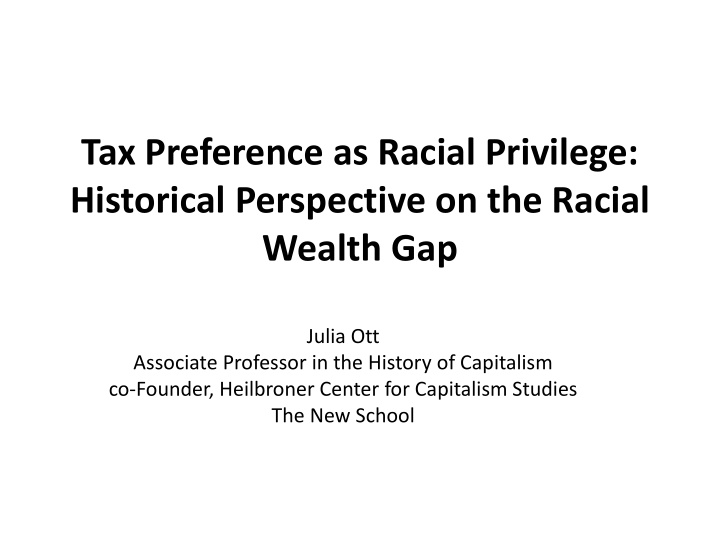



Tax Preference as Racial Privilege: Historical Perspective on the Racial Wealth Gap Julia Ott Associate Professor in the History of Capitalism co-Founder, Heilbroner Center for Capitalism Studies The New School
Top Federal Income Tax Rates vs. Effective Rate on Capital Gains in the United States, 1913-2010 Percentage 100 90 80 70 60 50 40 30 20 10 Top Regular Rates on Wages & Other Earned Income Maximum Tax Rate on Capital Gains Effective Rate on Capital Gains 2 0 Source: Citizens for Tax Justice, “Top Federal Income Tax Rates Since 1913” (November 2011) http://www.ctj.org/pdf/regcg.pdf; Tax Policy Center 2
Source: CBO
Source: CBO
Income Share of the Top 1% of Earners, 1913-2010 Percentage 25 20 15 10 5 Capital Gains Fully Excluded Capital Gains Fully Included 0 1913 1918 1923 1928 1933 1938 1943 1948 1953 1958 1963 1968 1973 1978 1983 1988 1993 1998 2003 2008 Source: Thomas Piketty and Emanuel Saez , “Income Inequality in the United States, 1913 - 2011” http://elsa.berkeley.edu/~saez/ 5
“ ” ’ – – ’ Top Capital Gains Tax Rates and Economic Growth, 1950-2011 45 10 Maximum Capital Gains Tax Rate (left axis) 40 % Change in Real GDP (right axis) 8 35 6 30 4 25 20 2 15 0 10 -2 5 Correlation = 0.12 0 -4 1950 1960 1970 1980 1990 2000 2010 Year Source: Leonard Burman , “Tax Reform and Tax Treatment of Capital Gains” (September 20, 2012)
Ben Shahn, 1946
Larry Gonick and Steve Atlas, 1977
Larry Gonick and Steve Atlas, 1977
Larry Gonick and Steve Atlas, 1977
Larry Gonick and Steve Atlas, 1977
Larry Gonick and Steve Atlas, 1977
Larry Gonick and Steve Atlas, 1977
It is futile to argue about how much money McGovern proposes to take away from you under his sundry tax programs, because he proposes to take it all. - Ayn Rand, Saturday Review , Oct 21, 1972, p. 50
“My Sticker Incentive Chart”
Recommend
More recommend